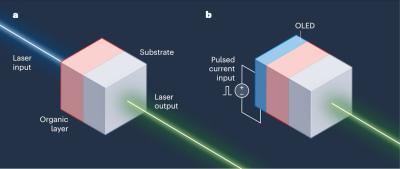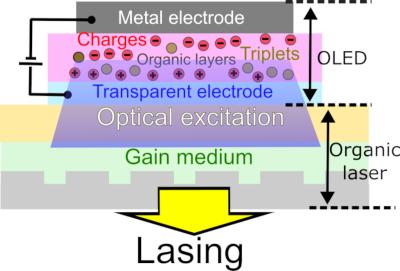Dr. Kou Yoshida and Dr. Junyi Gong, from the University of St Andrews, working with Prof. Ifor Samuel and Prof. Graham Turnbull, have developed an integrated organic laser device, based on an electrically-pumped laser.
In this work, the researchers developed and electrically driven organic electronic laser, with a narrow emission spectrum and the formation of a laser beam above the threshold. The researchers have shown that indirect electrical pumping by an OLED is a very effective way of realizing an electrically driven organic semiconductor laser.
As part of this groundbreaking work, the researchers have demonstrated a pulsed OLED device with the highest light output (47 W/cm2) ever - in fact it is more than double the intensity of any OLED previously made. The green OLED device emits at 430 nm, and is ten times higher in light output compared to any previous OLED with the same wavelength range.
Prof. Samuel says that the main finding, on the OLED side of the research, is that OLED devices can be very fast and very bright - possibly much faster and brighter than people thought possible considering the low mobilities of organic semiconductors. A standard OLED display emits light at about mW/cm2, so the pulsed OLED is extremely bright - but of course running it continuously will not be straightforward, especially as managing the high heat will be a problem.
Prof. Samuel explains further that the OLED emission itself was not intense enough to exceed the laser threshold, and so the researchers used a polymer coupling layer between the OLED and the laser, in order to avoid the out-coupling losses and exceed the laser threshold.
The researcher tested the laser for about 100,000 pulses, which is quite good for a first device, especially as it runs at around 10,000,000 times higher current density than normal OLED devices. The researchers estimate that such a device could be ready for commercialization in a few years, but there's still work to be done.



